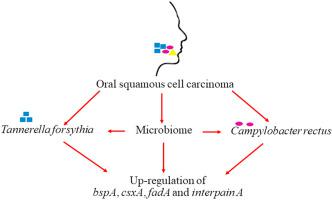Microbial Pathogenesis ( IF 3.8 ) Pub Date : 2020-08-25 , DOI: 10.1016/j.micpath.2020.104464 Mansour Moghimi 1 , Ronak Bakhtiari 2 , Jalil Fallah Mehrabadi 3 , Nagar Jamshidi 3 , Nazanin Jamshidi 3 , Abolghasem Siyadatpanah 4 , Watcharapong Mitsuwan 5 , Veeranoot Nissapatorn 5

|
Oral squamous cell carcinoma (OSCC) are one of the major causes of cancer morbidity and mortality worldwide. Dental microbiome has been considered as inducing agents in oral carcinogenesis. Therefore, the objective of this study was to investigate the interaction of the gene expression of the dental microbiome and OSCC patients. A cross-sectional study was designed by recruiting confirmed OSCC patients attending the University hospital during October 2018 and July 2019. The dental bacteria were isolated and confirmed by PCR technique. The expression of host and bacterial virulence genes was determined using qPCR. This study shows that 54% of T. forsythia found to be the most predominant organisms in 30 positive cases, followed by 34% of Campylobacter rectus and 29% of Prevotella intermedia. The expression of mRNA levels of bspA, csxA, fadA and interpain A in the OSCC- bacteria positive cases was significantly higher than the control group (P < 0.001). It was further found that interpainA, csxA, fadA, and bspA genes have the potential effects on the cellular gene expression in OSCC patients. A significant correlation was seen between expression patterns of CXCL10, DIAPH1, NCLN and MMP9 genes with interpain A, fadA, and bspA involved in OSCC cases The results indicate that the species specific bacteria may play a role in triggering chronic inflammation in OSCC patients. Therefore, alteration in the gene expression through the dental microbiome could be used as an alternative target in the clinical practice to detect OSCC.
中文翻译:

人类口腔癌的相互作用与牙齿致病细菌毒力基因的表达。
口腔鳞状细胞癌(OSCC)是全世界癌症发病率和死亡率的主要原因之一。牙科微生物组已被认为是口腔癌发生过程中的诱导剂。因此,本研究的目的是研究牙科微生物组与OSCC患者的基因表达之间的相互作用。通过招募2018年10月至2019年7月在大学医院就诊的OSCC确诊患者,设计了一项横断面研究。通过PCR技术分离并确认了牙菌。使用qPCR确定宿主和细菌毒力基因的表达。这项研究表明,在30例阳性病例中,占54.%的连翘是最主要的微生物,其次是直肌弯曲杆菌34%和中间普氏杆菌29%。在OSCC细菌阳性病例中,bspA,csxA,fadA和interpain A的mRNA表达水平明显高于对照组(P <0.001)。进一步发现,interpainA,csxA,fadA和bspA基因对OSCC患者的细胞基因表达具有潜在的影响。CXCL10,DIAPH1,NCLN和MMP9基因的表达模式与interpain A,fadA和bspA i之间存在显着相关性与OSCC病例有关的结果表明,特定物种的细菌可能在触发OSCC患者的慢性炎症中起作用。因此,通过牙齿微生物组的基因表达改变可被用作临床实践中检测OSCC的替代靶标。

























 京公网安备 11010802027423号
京公网安备 11010802027423号